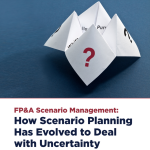Scenario Analysis is a tool to assist in making decisions under uncertainty. It provides a structured...

Introduction
In today’s dynamic and unpredictable business environment, financial forecasting has become essential for organisations seeking to make informed decisions and achieve their strategic goals. However, traditional forecasting methods often fall short in financial planning because of the inherent uncertainties and risks that businesses face. This is where Scenario Planning comes into play as a valuable tool, allowing FP&A professionals to analyse alternative futures and enhance their financial forecasts.
In this article, we will explore why and how Scenario Planning can significantly benefit financial forecasting. We will also discuss its advantages and shortcomings.
Why Scenario Planning?
-
Navigating Uncertainty
Traditional forecasting methods typically rely on historical data and linear projections. However, in an ever-changing business landscape, these approaches often overlook potential disruptive events, such as economic recessions, geopolitical tensions or technological advancements. Scenario Planning allows organisations to develop robust financial forecasts by explicitly considering a range of plausible future scenarios, thereby enabling better preparation for uncertainty.
-
Strategic Decision-Making
Financial forecasts are critical components in strategic decision-making processes. Businesses can evaluate different strategic options under various scenarios by implementing Scenario Planning. This empowers decision-makers to identify potential risks and opportunities, align resources, and make proactive choices, maximising the organisation’s resilience and competitiveness.
The Process of Scenario Planning
1. Identify Key Drivers
The first step in Scenario Planning is to identify the key external factors that may impact the organisation’s financial performance. These drivers could include economic indicators, regulatory changes, market trends, technological advancements or geopolitical events. We have to identify relevant and other drivers that may depend on uncertainty.
2. Develop Scenarios
Once the key drivers are identified, scenarios are developed based on different combinations of these drivers. Scenarios should represent plausible and contrasting futures, covering a spectrum of potential outcomes. It is crucial to involve cross-functional teams, subject matter experts, and stakeholders to ensure a comprehensive and diverse set of scenarios.
3. Quantify Financial Impacts
In this step, the financial impacts of each scenario are quantified. Organisations can use financial models, simulations, or statistical techniques to estimate the effects of the scenarios on key financial metrics, such as revenue, expenses, profitability, and cash flow. It can help us understand the range of potential outcomes and their associated probabilities.
4. Analyse and Interpret Results
This stage involves analysing the financial forecasts generated from Scenario Planning. Decision-makers should assess the resilience of their strategies under different scenarios, identify potential risks and opportunities, and evaluate the trade-offs associated with each scenario. It provides valuable insights to guide strategic decision-making.
Pros of Scenario Planning for Financial Forecasts
-
Enhanced Preparedness
Scenario Planning equips businesses with a proactive mindset, enabling them to anticipate and prepare for a range of possible futures. Companies can create contingency plans, assess capital requirements and optimise their resource allocation by considering a broad spectrum of scenarios. Consequently, it leads to improving their ability to weather uncertainties and mitigate risks effectively.
-
Strategic Agility
Scenario Planning promotes strategic agility by encouraging organisations to explore alternative paths and strategies. Such an approach can help decision-makers identify potential market disruptions, competitive threats, and emerging opportunities. It enables the enterprise to adapt quickly to changing circumstances and gain a competitive edge.
-
Improved Risk Management
Businesses can identify weak spots, develop risk mitigation strategies, and implement proactive measures to protect their financial well-being by stress-testing their financial forecasts against various scenarios.
Cons of Scenario Planning for Financial Forecasts
-
Complexity
Scenario Planning can be a time-consuming and resource-intensive process. Developing multiple scenarios and quantifying their financial impacts require careful analysis and coordination across different functions within the organisation. It may deter an entity from fully adopting Scenario Planning.
Challenges We Face and How to Mitigate These
1. Time & Resources
The Multiple Picnic Dilemma - just like organising several picnics simultaneously can be overwhelming, managing multiple projects or plans can drain our time and resources. Mitigate this challenge by prioritising the challenges by what is most important and tackle these in order, delegate various tasks to the experts in your teams, and use technology and different tools that support Scenario Planning.
2. Picking the Right Factors
Predicting the future, whether it’s the weather or business trends, can be tricky. Do your research on industry news and trends. Remember that knowledge is power, and consult with experts. Bringing in 3rd party resources with a different view can be beneficial. And most important, go into a Feedback Loop, regularly check in with the team and adjust strategies based on new information.
3. Deep Dives into Each Scenario
The ‘What-If’ Rabbit Hole - diving deep into every possible future scenario can be complex and time-consuming. Simplify the planning process and focus on high-impact factors, as not every detail needs a deep dive. Consider grouping scenarios. If some ‘what-ifs’ might have similar outcomes, group them to avoid redundancy and set boundaries by allocating a set amount of time for each scenario to avoid over-analysis.
4. Avoiding the Spread
The ‘Too Many Cooks’ Syndrome - having many plans can dilute our focus, just like having too many cooks can spoil the broth. Centralise information by using an integrated platform or tool where all plans are visible to everyone and knowledge can be shared. This way, overlaps can be spotted and reduced. Ensure having regular check-ins as regular team meetings can ensure everyone’s on the same page and efforts aren’t duplicated. Setting clear objectives and understanding main goals can ensure that plans align with them and avoid veering off course.
Conclusion
In conclusion, Scenario Planning emerges as an indispensable tool for financial forecasting in today’s unpredictable business landscape. While traditional methods are often insufficient for navigating uncertainties and risks, Scenario Planning offers a proactive approach to navigating the unknown. It allows organisations to consider and anticipate various plausible futures and enhance their risk management and strategic decision-making. But most importantly, it can help businesses get ready for uncertainty.
Subscribe to
FP&A Trends Digest

We will regularly update you on the latest trends and developments in FP&A. Take the opportunity to have articles written by finance thought leaders delivered directly to your inbox; watch compelling webinars; connect with like-minded professionals; and become a part of our global community.






